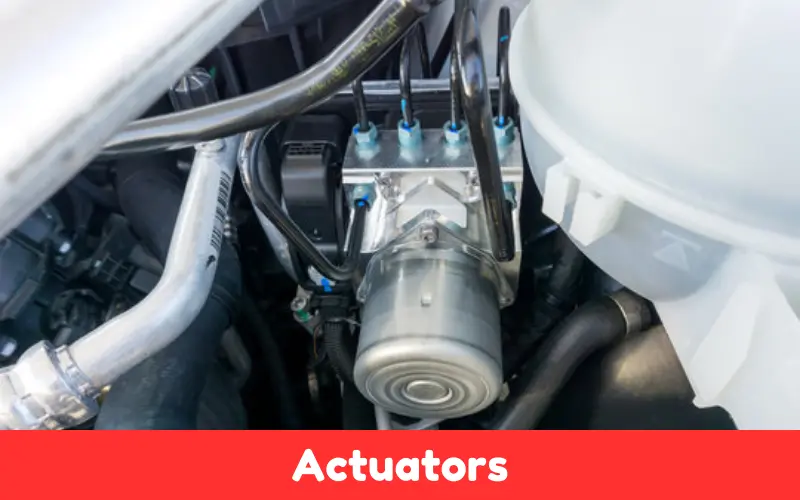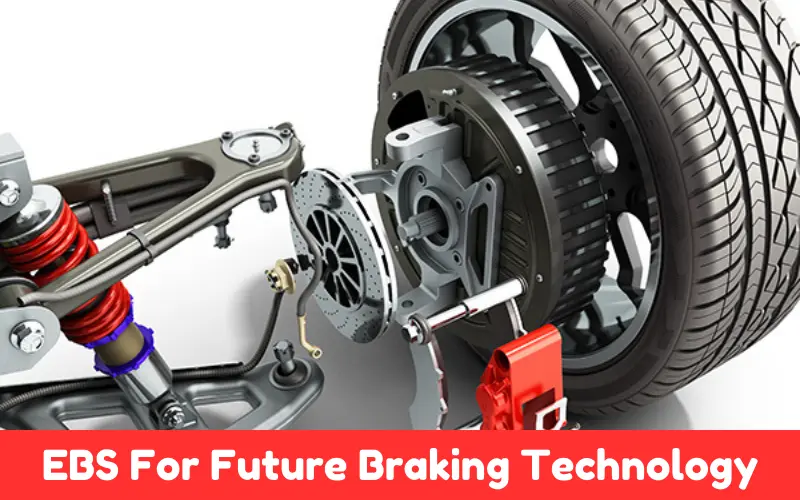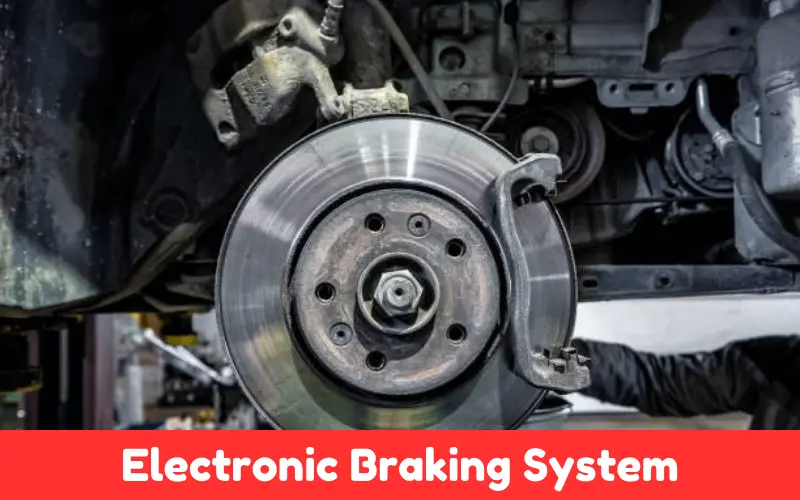Electronic Braking System (EBS) stands out in the changing landscape of automotive technology. It is proving to be a substantial technological advancement of vehicle braking system in terms of safety and performance.
The Electronic Braking System (EBS) is now a staple of the modern car, moving from rudimentary braking methods to an electronically controlled one.
Article Summary
- What is Electronic Braking System in Vehicle?
- How Does Electronic Braking System (EBS) Work?
- Advantages of Electronic Braking System (EBS)
- Electronic Braking System (EBS) For Future Braking Technology
- Servicing an Electronic Braking System (EBS)
- FAQs on What is Electronic Braking System (EBS)
- What is an EBS (Electronic Braking System)?
- How does Electronic Braking System (EBS) improve vehicle safety?
- What are the maintenance requirements for EBS compared to traditional braking systems?
- Is it even possible to add EBS for older vehicles?
- How does EBS communicate with other electronic safety systems in a vehicle?
- Conclusion
What is Electronic Braking System in Vehicle?
There is a question in car owners mind that what is Electronic Braking System? An electronic brake system (EBS) is an advanced vehicle brake-by-wire system that eliminates the need for most mechanical and hydraulic components.
EBS is not based on pure physical connections (mechanical and hydraulic parts) but sets its functions at the electronic level.
A set of sensors, actuators, and electronic control units work in concert to maximize low-dead-volume HybridTech 2 braking performance.
How Does Electronic Braking System (EBS) Work?
Sensors and Detection
EBS starts with a network of sensors positioned strategically throughout the vehicle. The sensors monitor wheel speed, pedal pressure, and vehicle dynamics.
They can detect the driver’s brake pedal inputs and convey that information to a central control unit each time the brakes are applied.
Electronic Control Unit (ECU)
The ECU is the main brain of the Electronic Braking System (EBS). It uses data received from the sensors and calculates how much braking force should be applied to each wheel, using real-time variables that include the vehicle’s speed, weight distribution, and terrain data.
Actuators

The ECU finds the required braking pressure and sends electronic signals to actuators located on all four wheels. The actuators then use this control to apply the brakes, ideally minimizing chassis pitch and roll and workload on individual wheels.
Advantages of Electronic Braking System (EBS)
Improved Safety
With an Electronic Braking System (EBS), you have an enhanced safety feature compared to traditional braking systems.
Processing real-time data and adjusting braking force at the speed of light to prevent skidding, this high-performance AWD system ensures vehicle stability under emergency scenarios.
Improved Response Time
Unlike the hydraulic pressure system, the EBS or enhanced bracing response is an ordinary electronic signal that allows faster functionality. This is important because how fast the response happens can determine whether a collision will occur and whether there’s enough stopping time.
Optimized Braking Force
Electronic Braking Systems (EBS) apply braking force more evenly on all wheels to minimize the rate of wear and tear per component. This means the components last longer and the vehicle is more balanced.
System Integration
EBS is seamlessly integrated with other electronic safety systems, such as ABS, ESC, and TCS. This integration increases vehicle safety and performance.
Less maintenance
Electronic Brake Systems (EBS) have fewer mechanical parts and no hydraulic fluid, so they need to be maintained only occasionally compared with traditional brakes. This means fewer costs for vehicle owners in the long term.
Electronic Braking System (EBS) For Future Braking Technology

Applying this to the automotive industry, as car technology continues to advance, it is likely that an Electronic Braking System (EBS) will also develop.
The addition of machine learning and artificial intelligence could make these types of braking systems even smarter, potentially enabling the brakes to anticipate driver actions or conditions in a road segment.
Moreover, materials and actuator technologies are expected to develop further to improve EBS’s performance (efficiency maintainability).
Servicing an Electronic Braking System (EBS)
It is important to keep the Electronic Braking System (EBS) in shape so that modern vehicles, which are mostly equipped with EBS, perform well and ensure a safe drive.
Because EBS can regulate braking electronically using controls, sensors, and actuators, it’s more efficient and faster than conventional systems. How to keep your EBS health.
Standardized Inspections
Comprehensive inspections are conducted regularly on the EBS components (sensors, actuators, and electronic control unit ECU). Check for wear, corrosion, or any other damage. Check all connections and make sure they are clean, full of trash, etc.
Diagnostic tests
Utilize advanced diagnostic equipment to scan EBS for trouble codes. Tools can help us find issues that are not visible when inspecting physically. If you have any error codes, deal with them immediately to avoid causing more damage.
Software Updates
Entire EBS applications should be kept at the latest version and updated with all patches and updates. Manufacturers release updates frequently to improve system performance or resolve existing issues. Make a habit of checking for and installing these updates.
Brake Pad and Rotor Maintenance
Despite the reduction in wear facilitated by EBS, brake pads, and rotors still need to be frequently maintained. Check and replace pads and rotors as necessary to ensure consistent braking.
Pro Servicing
Get your EBS serviced by professionals who know the ins and outs of electronic braking systems. They are able to perform detailed diagnostics, repairs, and even updates, all designed so the system continues performing as needed.
Following these service guidelines will help maintain the dependable and safe braking performance of your EBS.
FAQs on What is Electronic Braking System (EBS)
What is an EBS (Electronic Braking System)?
Electronic Braking System (EBS) is an improved braking system in which electronic controls are used instead of mechanical and hydraulic components to manage the bricking process. This incorporates sensors, actuators, and electronic control units (ECUs) to improve braking performance and enhance safety with response times.
How does Electronic Braking System (EBS) improve vehicle safety?
EBS ensures improved vehicle safety by offering faster reaction times and accurate braking force control, automobile news & reviews. It uses data from sensors to determine in real-time the correct amount of braking pressure, relying mostly on preventing skidding as a means of stability. Moreover, the EBS is well linked with not only the anti-lock brake system (ABS) but also electronic stability control (ESC), which largely favors safety in general.
What are the maintenance requirements for EBS compared to traditional braking systems?
While the fewer mechanical parts and no need for hydraulic fluid make EBS easier to maintain than conventional braking systems, maintenance is still a task. Therefore, you need fewer routine inspections and replacements of comfort parts like brake lines and fluid. However, the crucial thing is to ensure that all of its other electronic parts and sensors are working as expected, and this may require some diagnostic tools.
Is it even possible to add EBS for older vehicles?
Fitting older vehicles with EBS has its challenges and is not always possible. The process would involve major changes to the vehicle’s braking system, sensors and actuators, and electronic control units (ECUs) for integration with BMW’s existing electronics. As you can see, it is well suited for the kind of modern vehicles that have made EBS a reality as electronic systems are integrated into next-generation (and even current) air cars.
How does EBS communicate with other electronic safety systems in a vehicle?
But EBS works with different automotive electronic safety systems like ABS (Anti-lock Braking System), ESC (Electronic Stability Control), and TCS. Thanks to shared data and coordinated actions, these systems can improve vehicle stability, prevent wheel lockup (or locked wheels), and reduce skidding on ice or snow-covered roads while also maintaining forward traction with all four wheels. This scheme brings all these things together so that the system functions at a level of safety and performance greater than any individual piece.
Conclusion
It would be a major milestone in vehicle safety and handling with the advent of Electronic Braking Systems.
EBS uses electronic controls and real-time data processing for quicker response times, optimized braking force, and full integration with other safety systems.
In a future of intelligent and autonomous vehicles, EBS is all but certain to take on new importance in transportation, bridging the gap for ever safer and more efficient transportation.

